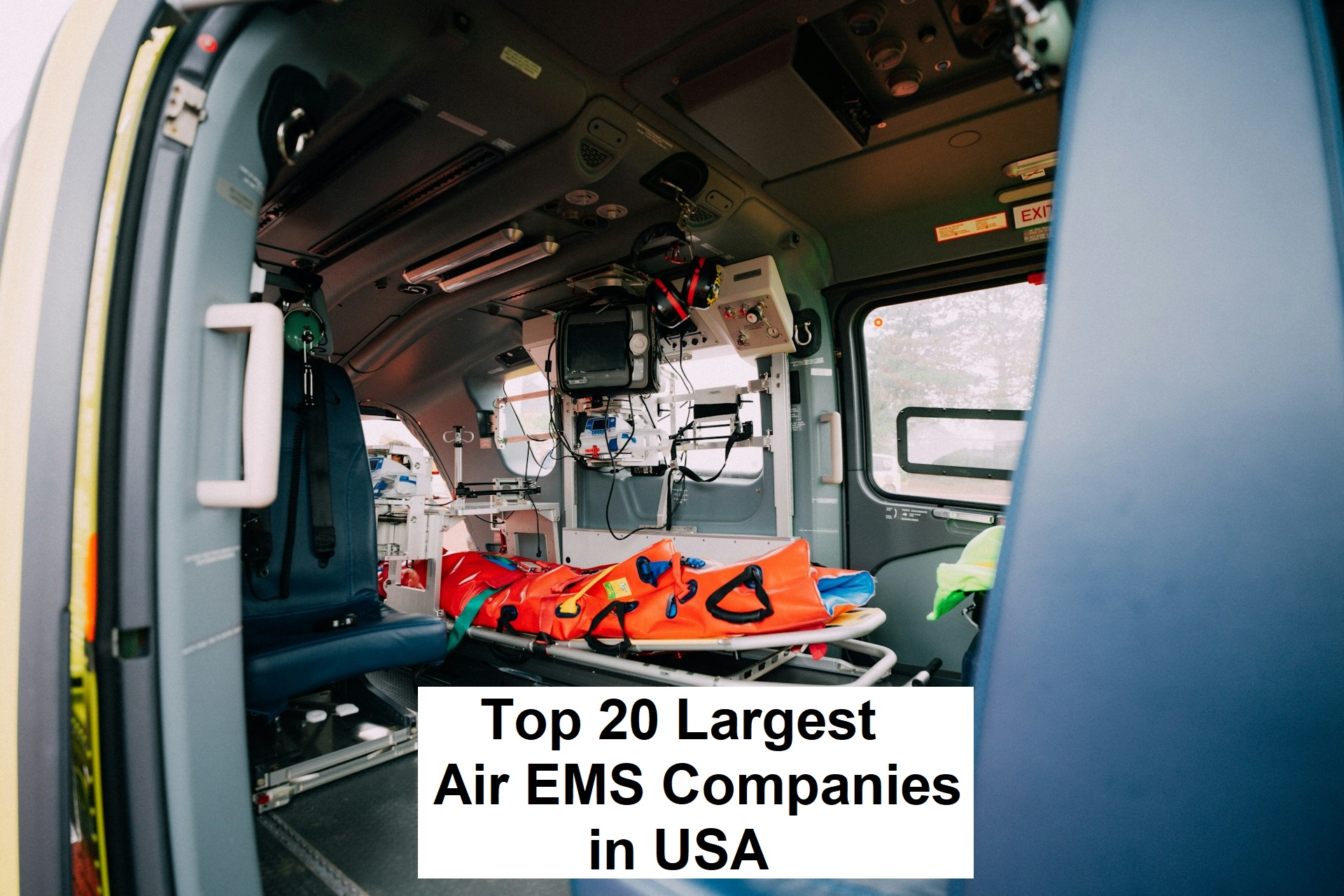Air Emergency Medical Services (EMS) play a critical role in providing life-saving medical care and rapid patient transportation. These services are essential in emergencies where time-sensitive care is required, such as heart attacks, strokes, or traumatic injuries. Air EMS typically utilizes helicopters and fixed-wing aircraft equipped with advanced medical equipment and staffed by highly trained medical professionals. The vast geography of the United States, including remote and rural areas, makes air transport indispensable for bridging gaps in healthcare access.
Importance of Air EMS Companies
The importance of Air EMS companies lies in their ability to save lives by reducing response times and ensuring patients receive immediate medical attention. They also support hospitals during natural disasters or large-scale emergencies by transporting critical patients or medical supplies. Furthermore, these companies contribute to healthcare innovation by adopting cutting-edge technologies like telemedicine and advanced monitoring systems, ensuring high-quality patient care during transit.
Criteria for Ranking the Largest Air EMS Companies
Factors Considered in the Selection of Air EMS Companies
When ranking the largest Air EMS companies in the USA, several factors are considered:
- Fleet Size and Type: The number and type of aircraft (helicopters or fixed-wing) directly impact a company’s capacity to serve diverse needs.
- Geographic Coverage: Companies with extensive networks across multiple states or regions rank higher due to their broader accessibility.
- Service Quality: Accreditation by organizations like CAMTS (Commission on Accreditation of Medical Transport Systems) reflects high standards of safety and care.
- Revenue and Market Share: Financial performance indicates a company’s stability and ability to invest in advanced medical technologies.
- Specialized Services: Companies offering neonatal transport, ECMO support, or international evacuations stand out for their versatility.
These criteria ensure a comprehensive evaluation of each company’s contributions to the Air EMS industry.
Evolution of Air EMS Services in the USA
The concept of air medical services dates back to military operations during World War I when planes were used to transport injured soldiers. By 1947, civilian air ambulance services emerged in Los Angeles, marking the beginning of modern Air EMS in the USA. The 1970s saw significant advancements with paramedics joining air crews, transforming air ambulances into flying intensive care units (ICUs).
Over the decades, technological innovations like GPS navigation, telemedicine integration, and advanced medical equipment have revolutionized air ambulance operations. Today, Air EMS services are indispensable for responding to emergencies in remote areas, providing inter-facility transfers for critically ill patients, and supporting disaster relief efforts nationwide. The industry’s growth has been fueled by increasing demand for rapid medical transport and advancements in aviation technology.
Leading Air EMS Companies: An Overview
Key Players in the Industry
The U.S. Air EMS market is dominated by industry leaders such as Air Methods Corporation, Global Medical Response (GMR), PHI Air Medical, and REVA Inc., among others. These companies operate extensive fleets of helicopters and airplanes equipped with state-of-the-art medical technology to provide comprehensive emergency services across urban and rural areas.
Market Share and Reach
Air Methods Corporation leads the market with over one-third of total industry revenue, followed closely by Global Medical Response (GMR). These companies have established nationwide networks that include partnerships with hospitals, fire departments, and local governments to ensure seamless operations.
Innovations and Technology Adoption
Leading companies continuously invest in innovations like telemedicine systems that enable real-time consultations during flights and advanced avionics for safer navigation. These technologies enhance patient outcomes while improving operational efficiency.
Regional Distribution of Air EMS Providers
Air EMS providers operate across all 50 states but exhibit varying levels of coverage based on population density and geographic challenges. Helicopter Emergency Medical Services (HEMS) are more prevalent in densely populated urban areas where quick response times are critical. In contrast, fixed-wing aircraft are used for long-distance transports in rural regions or between states.States like Texas, California, Florida, and New York have some of the highest concentrations of Air EMS providers due to their large populations and diverse terrains. Conversely, sparsely populated states rely heavily on regional providers or national networks like PHI Air Medical or REVA Inc., which specialize in serving remote locations. This article will continue with sections on challenges faced by Air EMS companies, their role during emergencies, partnerships with healthcare systems, future trends in the industry
Challenges Faced by Air EMS Companies
Air EMS companies face several challenges that impact their operations, financial sustainability, and service delivery.
Financial Constraints and Operational Costs
Operating air ambulances is expensive, with costs including aircraft maintenance, fuel, advanced medical equipment, and highly trained personnel. Many patients face prohibitive expenses due to limited insurance coverage, leaving them with significant out-of-pocket costs. Additionally, reimbursement rates from insurers often fail to cover operational expenses, creating financial strain for providers. These constraints limit the accessibility of air ambulance services to underserved populations and rural areas.
Regulatory and Safety Challenges
Air EMS providers must comply with complex federal, state, and local regulations, which can vary widely across jurisdictions. This creates administrative burdens and uncertainty for companies. Safety remains a critical concern due to risks like adverse weather conditions, aircrew fatigue, and aircraft maintenance issues. Ensuring compliance with safety standards while managing operational demands is a constant challenge.
Workforce Shortages
A shortage of skilled pilots, paramedics, and support staff further strains the industry. High-stress work environments lead to burnout and high turnover rates among employees. Recruiting and retaining qualified professionals is difficult due to low wages and demanding schedules, which compromises service delivery and response times.
Role of Air EMS During Emergencies and Natural Disasters
Air EMS services are indispensable during emergencies and natural disasters, providing rapid medical assistance when ground transportation is unavailable or impractical. For instance, during the 2023 earthquakes in Turkey and Syria, air ambulances played a crucial role in reaching inaccessible areas quickly, delivering medical supplies, and transporting critically injured patients to hospitals.
One of the key advantages of air ambulances in disaster scenarios is their ability to bypass damaged infrastructure such as blocked roads or collapsed bridges. Helicopters can land in remote or disaster-stricken areas where conventional vehicles cannot operate. This flexibility enables air EMS providers to collaborate effectively with other emergency responders like firefighters and paramedics.
Moreover, air ambulances are equipped with advanced medical technology that allows for life-saving interventions during transit. Patients requiring specialized care—such as trauma victims or those needing immediate surgery—benefit significantly from the reduced transport time offered by air EMS services. In disaster relief efforts, every minute counts, making air ambulances a vital component of emergency response systems worldwide.
Partnerships with Hospitals and Healthcare Systems
Collaboration between Air EMS companies and healthcare systems is essential for ensuring seamless patient care. These partnerships allow hospitals to extend their reach into rural or underserved areas by relying on air ambulances for rapid patient transfers. For example, many Air EMS providers establish contracts with hospitals to facilitate inter-facility transfers for critically ill patients requiring specialized treatment.
Additionally, partnerships help integrate air ambulance services into broader healthcare networks, improving coordination during emergencies. Hospitals often rely on Air EMS providers for timely transport of organs for transplants or neonatal patients requiring advanced care unavailable locally. Such collaborations enhance the efficiency of healthcare delivery while optimizing resource utilization.
However, these partnerships also present challenges. Differences in protocols between hospitals and Air EMS providers can lead to delays or miscommunication during critical situations. To address these issues, many organizations invest in joint training programs and technology-driven solutions like telemedicine platforms that enable real-time communication between flight crews and hospital staff.
Future Trends in Air EMS Services
The future of Air EMS services is shaped by advancements in technology and evolving healthcare needs. One notable trend is the adoption of telemedicine systems onboard aircraft, enabling real-time consultations between flight crews and specialists on the ground. This innovation improves patient outcomes by facilitating accurate diagnoses and treatment decisions during transit.
Another emerging trend is the use of electric vertical takeoff and landing (eVTOL) aircraft for medical transport. These eco-friendly vehicles promise to reduce operational costs while minimizing environmental impact. Companies like Joby Aviation are already exploring eVTOL applications in emergency medical services.
Artificial intelligence (AI) is also transforming the industry by enhancing route optimization and predictive maintenance for aircraft. AI-powered systems analyze weather conditions, traffic patterns, and patient needs to determine the most efficient flight paths while ensuring safety.
As demand for Air EMS services grows due to aging populations and increasing chronic illnesses, companies are expanding their geographic coverage through partnerships and acquisitions. The integration of unmanned aerial vehicles (UAVs) for delivering medical supplies in remote areas further underscores the industry’s commitment to innovation.
Top 20 Largest Air EMS Companies in the USA (List)
Here’s a detailed look at some of the largest Air EMS companies operating across the United States:
- Air Methods Corporation: The largest provider with over 300 bases nationwide offering HEMS (Helicopter Emergency Medical Services).
- Global Medical Response (GMR): Parent company of AMR Air Ambulance and Med-Trans Corporation; operates an extensive fleet serving urban and rural areas alike.
- PHI Air Medical: Known for its high safety standards; operates helicopters equipped with cutting-edge medical technology.
- REVA Inc.: Specializes in fixed-wing air ambulance services for long-distance patient transfers.
- Metro Aviation: Offers customized air medical transport solutions through partnerships with hospitals.
- Guardian Flight: Focuses on serving remote regions like Alaska; part of GMR’s network.
- Life Flight Network: A nonprofit organization providing critical care transport across the Pacific Northwest.
- Air Evac Lifeteam: Operates primarily in rural areas; part of GMR’s extensive network.
- CareFlite: Based in Texas; provides both helicopter and fixed-wing transport services.
- MedFlight: A nonprofit provider serving Ohio with a focus on collaborative healthcare solutions.
- Air Medical Group Holdings (AMGH): A subsidiary of Global Medical Response, AMGH operates multiple brands like Med-Trans and Air Evac Lifeteam, delivering critical care transport across the country.
- Classic Air Medical: Known for its operations in rugged terrains, Classic Air Medical serves rural and remote areas in the Western U.S. with a fleet of helicopters and fixed-wing aircraft.
- CALSTAR (California Shock Trauma Air Rescue): A nonprofit organization providing air ambulance services in California and Nevada, CALSTAR is renowned for its high-quality care and safety standards.
- Northwest MedStar: Serving the Pacific Northwest, this provider focuses on rapid response times and patient-centered care.
- AeroCare Medical Transport System: Specializes in domestic and international fixed-wing air ambulance services with a focus on long-distance patient transfers.
- Med-Trans Corporation: A leader in helicopter emergency medical services (HEMS), Med-Trans operates nationwide with partnerships with hospitals and healthcare systems.
- Air St. Luke’s: Based in Idaho, this provider offers regional air ambulance services with a focus on neonatal and pediatric critical care.
- STAT MedEvac: Operated by the Center for Emergency Medicine of Western Pennsylvania, STAT MedEvac is one of the largest nonprofit air ambulance providers in the U.S.
- EagleMed: A division of AMGH, EagleMed provides both helicopter and fixed-wing transport services across several states.
- Angel MedFlight: Specializes in luxury medical transport with highly trained staff and state-of-the-art aircraft for long-distance transfers.
These companies represent a mix of for-profit and nonprofit organizations, each contributing to the Air EMS industry through innovation, safety, and exceptional patient care.
FAQs About Air EMS Companies
What is Air EMS?
Air Emergency Medical Services (EMS) refers to the use of helicopters or fixed-wing aircraft to provide rapid medical assistance and transportation for critically ill or injured patients. These services are vital for emergencies where time-sensitive care is required or when ground transportation is impractical.
How much does an air ambulance cost?
The cost of air ambulance services can range from $10,000 to $50,000 or more, depending on factors like distance traveled, type of aircraft used, and level of medical care provided during transit. Insurance coverage varies widely and often does not fully cover these expenses.
Are Air EMS companies safe?
Yes, safety is a top priority for Air EMS providers. Companies adhere to strict regulatory standards set by agencies like the Federal Aviation Administration (FAA) and often seek accreditation from organizations like CAMTS (Commission on Accreditation of Medical Transport Systems). Advanced training for pilots and medical crews further ensures safety during operations.
Who can use Air EMS services?
Air EMS services are typically used for critically ill or injured patients who require immediate medical attention or specialized care unavailable locally. These services are also utilized for organ transportation, neonatal transfers, and disaster relief efforts.
Sum Up
The Air EMS industry plays a vital role in saving lives by providing rapid medical assistance and transportation across the United States. From urban hubs to remote rural areas, these companies bridge gaps in healthcare access while continuously innovating to improve patient outcomes. Despite challenges such as financial constraints, regulatory hurdles, and workforce shortages, leading providers like Air Methods Corporation, Global Medical Response (GMR), PHI Air Medical, and others have established themselves as indispensable players in emergency healthcare.
As technology evolves, trends like telemedicine integration, eVTOL adoption, and AI-driven efficiency promise to transform the industry further. Partnerships with hospitals and healthcare systems remain crucial for expanding service coverage and ensuring seamless patient care.














